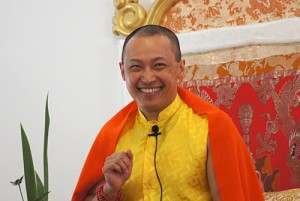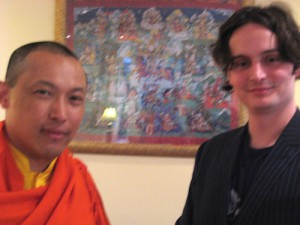Friday
Featured Stories, Sakyong and FamilyA Leader for Our Times: Interview with Sakyong Mipham Rinpoche
 Interview by Monty McKeever for Tricycle Magazine
Interview by Monty McKeever for Tricycle Magazine
Many of the borders between cultures have blurred in today’s world. Sherpas on Himalayan peaks can watch pop stars on iPhones and teenagers in Michigan read ancient Buddhist texts on the internet. Yet as modernity and the information age bring forth exciting new possibilities for insight, communication, and connection, they also bring new potential for confusion, isolation, and aggression. These times demand teachers who understand them. Sakyong Mipham Rinpoche, son of revered teacher Chogyam Trungpa Rinpoche, who founded the Shambhala lineage that the Sakyong now heads, is not only a teacher that is adept at making the dharma accessible in these rapidly changing times: He was born of them.
Raised throughout Europe and North America, as well as Asia, he is also very much a product of the West, a hardworking family man seeking to navigate all the vagaries of the modern world. It is no surprise that tens of thousands of practitioners across the globe are drawn to the Sakyong as they too work to practice the dharma amid all the challenges and uncertainties of this age.
Last August, during the Being Brave: Transforming Our World program in Halifax, Nova Scotia, I had the chance to sit and talk with the Sakyong. Visit the Tricycle Retreat led by the Sakyong and Ani Pema Chodron here.
~ Monty McKeever
Please tell me about your early training. Who were your teachers? As someone trained in multiple traditions and who has lived in multiple cultures, were there any aspects of your training that people may find surprising?
Reflecting back, I feel like my father brought me into the world intentionally, for the purpose of continuing his vision and his intention. Behind that, I was imparted to be a Buddhist teacher and to hold that lineage. At the same time, I think he was trying to establish, evolve, and create a unique lineage, which has become the lineage of Sakyongs. So my training reflects that, I had traditional training in Buddhist law, philosophy, and ritual at the same time the tradition of warriorship and the arts, politics, philosophy, in terms of the West.
My father was very hands-on. Every day he would ask what I was doing, both in the family sense and also to see if I had finished my recitations of certain mantras and things like that. Early on I was in India, and I grew up speaking Tibetan and Hindi. Then, when I went to England and Scotland I learned English. When I came West, I did a lot of the programs and public events that my father was doing and I continued training in the martial arts and contemplative disciplines. I would say it was a universal education, with parts of traditional Japanese, Chinese, Tibetan, English, and Western culture. I think it was very unusual. Later, after the passing of my father, I was with His Holiness Dilgo Khyentse Rinpoche for almost four years, continuing to study tantra and receive empowerments. He took special care to complete my education. Later I received education more in philosophy and metaphysics with Penor Rinpoche.
You are known for integrating the more secular elements of Shambhala and the more traditional Tibetan Buddhist elements of Shambhala into the single banner of Shambhala Buddhism. Now, in Shambhala Buddhism, there’s Tibetan Buddhist elements, Zen and Shinto elements, Bon Rituals, as well as Western and Asian cultural practices. What do these all have in common? How do they all relate to Buddhism?
The single defining quality is that Shambhala has, as its main principle, a social vision of creating a wakeful good society, using the wisdom traditions of the world. That was my father’s wish and intention. When he left Tibet, I think he came to a crossroads, and his inspiration to continue on as a teacher, and to start Shambhala, was for the express purpose of trying to create a lineage and a culture of social transformation. All the elements that are involved within the Shambhala tradition now, are for that express purpose. The basis of Buddhism is essentially the notion that Dharma can alleviate suffering on a personal level, and in the case of the Shambhala teachings, on a societal level. Alleviating suffering was Buddha’s intention. The notion of Shambhala is, how do you take this wisdom and make it applicable to what’s going on in the modern tradition.
 We are currently in the midst of the Being Brave, Transforming Our World program that you are teaching, with Pema Chodron and Acharya Adam Lobel. Can you tell our readers about this program? How can bravery transform the world?
We are currently in the midst of the Being Brave, Transforming Our World program that you are teaching, with Pema Chodron and Acharya Adam Lobel. Can you tell our readers about this program? How can bravery transform the world?
The program, Being Brave, is highlighting the essential aspects of the Shambhala teachings, which is the notion of warriorship—that we must be courageous and brave. Bravery is thematic, as Shambhala has to deal with the notion of not being overwhelmed by adversity. The notion of warrior is never giving up. Bravery is a key element. Can we raise our energy and raise our strength to actually influence and participate in society and try to help it go in a direction of hope and human betterment? Right now, can we be compassionate? If we’re not brave, none of these elements will come out, so bravery is very much an action and engagement.
What are your thoughts and feelings as we approach the 25th Parinirvana [final nirvana, i.e. death of an enlightened master] of your father?
I think that he would be proud. His vision and dream has survived through quite a lot of adversity and challenges. Not only that, but I think we are actually flourishing. I’ve been reflecting more and more on how amazing his burden was, and his visionary quality. It’s been 50 years since he escaped Tibet and went to India, and he had this social vision and this vision of how Buddhists can change the basis of society. Now, here we are in Nova Scotia and in Shambhala centers around the world, in a culture where this vision is becoming more and more important. 25 years is an interesting amount of time, because it seems to be almost a generation, so now, time has really moved on, and it is a very different world. I think more than ever now, we’re being propelled forward into the future, so his Parinirvana is a celebration, a remembering, and an excellent reminder to put into effect what he began.
You’re a teacher, but you’re also the Sakyong, which means, “Earth Protector,” and is also commonly defined as king. You’re a King in an age where there are not that many Kings, and some people have trouble with the idea of a modern Buddhist king. Can you shed some light on this? How do you see your role as a king?
Well, it’s been an interesting journey. I was enthroned in this role when I was very young. Even my father said to me that this notion of Sakyong is something that doesn’t really exist right now. It is a unique position, role, and duty that could maybe be likened to, in the West, a philosopher king, or in the Chinese tradition, a sage king. It’s the notion of a ruler who takes care of society with benevolence and goodness, and at the same time, expounds spirituality. The analogy is that we are all meant to be Sakyong and Sakyong Wangmo, the king and queen, and not strictly in the sense of being royalty, but as possessors of our potency. One of the key criteria of leadership in our tradition is that one rules and leads completely as a path of benefiting others.
I think it’s interesting because these days, there’s just so much confusion about leadership altogether, from any political denomination. It really has to come back to the notion of honor, duty and decency. These roles have existed in the past and, and in terms of my community, this is the role and position that I hold. I see that it’s important for me to hold it, because it provides the opportunity for me to help others and protect the teachings, so I see it as a protector and I see it as a leader, guide, and friend.
Continue reading the interview by clicking here.




